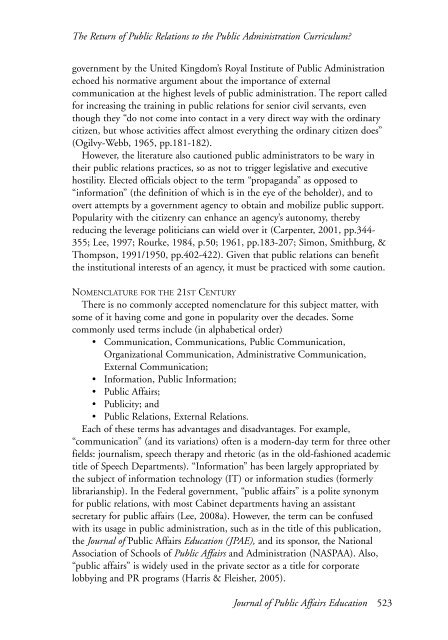JOURNAL OF PUBLIC AFFAIRS EDUCATION - National ...
JOURNAL OF PUBLIC AFFAIRS EDUCATION - National ...
JOURNAL OF PUBLIC AFFAIRS EDUCATION - National ...
You also want an ePaper? Increase the reach of your titles
YUMPU automatically turns print PDFs into web optimized ePapers that Google loves.
The Return of Public Relations to the Public Administration Curriculum?<br />
government by the United Kingdom’s Royal Institute of Public Administration<br />
echoed his normative argument about the importance of external<br />
communication at the highest levels of public administration. The report called<br />
for increasing the training in public relations for senior civil servants, even<br />
though they “do not come into contact in a very direct way with the ordinary<br />
citizen, but whose activities affect almost everything the ordinary citizen does”<br />
(Ogilvy-Webb, 1965, pp.181-182).<br />
However, the literature also cautioned public administrators to be wary in<br />
their public relations practices, so as not to trigger legislative and executive<br />
hostility. Elected officials object to the term “propaganda” as opposed to<br />
“information” (the definition of which is in the eye of the beholder), and to<br />
overt attempts by a government agency to obtain and mobilize public support.<br />
Popularity with the citizenry can enhance an agency’s autonomy, thereby<br />
reducing the leverage politicians can wield over it (Carpenter, 2001, pp.344-<br />
355; Lee, 1997; Rourke, 1984, p.50; 1961, pp.183-207; Simon, Smithburg, &<br />
Thompson, 1991/1950, pp.402-422). Given that public relations can benefit<br />
the institutional interests of an agency, it must be practiced with some caution.<br />
NOMENCLATURE FOR THE 21ST CENTURY<br />
There is no commonly accepted nomenclature for this subject matter, with<br />
some of it having come and gone in popularity over the decades. Some<br />
commonly used terms include (in alphabetical order)<br />
• Communication, Communications, Public Communication,<br />
Organizational Communication, Administrative Communication,<br />
External Communication;<br />
• Information, Public Information;<br />
• Public Affairs;<br />
• Publicity; and<br />
• Public Relations, External Relations.<br />
Each of these terms has advantages and disadvantages. For example,<br />
“communication” (and its variations) often is a modern-day term for three other<br />
fields: journalism, speech therapy and rhetoric (as in the old-fashioned academic<br />
title of Speech Departments). “Information” has been largely appropriated by<br />
the subject of information technology (IT) or information studies (formerly<br />
librarianship). In the Federal government, “public affairs” is a polite synonym<br />
for public relations, with most Cabinet departments having an assistant<br />
secretary for public affairs (Lee, 2008a). However, the term can be confused<br />
with its usage in public administration, such as in the title of this publication,<br />
the Journal of Public Affairs Education (JPAE), and its sponsor, the <strong>National</strong><br />
Association of Schools of Public Affairs and Administration (NASPAA). Also,<br />
“public affairs” is widely used in the private sector as a title for corporate<br />
lobbying and PR programs (Harris & Fleisher, 2005).<br />
Journal of Public Affairs Education 523

















